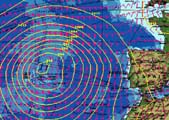 |
The Official
|
| www.sailing.org |
17 October 2002, 03:09 pm
Class Two Yachts Head for Shelter

The Weather Pattern ApproachingWestern Europe©Raymarine
Around Alone - Leg Two
Torbay (GBR) - Cape Town (RSA)
There are few occasions in an Around Alone skippers mind that calls for more soul searching than making a decision to seek shelter from an approaching storm.
On the other hand, even Around Alone skippers are human, and with the prospect of placing yourself and your boat squarely in danger, it suddenly becomes much easier to seek refuge. For the Class 2 boats that are heading for La Coruna on the northwest coast of Spain, their decisions have been made and I am sure that the sailors have no problem now that they have come to terms with their choice. It's the other yachts still out on the race course that are having to wrangle with weighing the option of prudent seamanship against losing time and distance, when both are the very essence of ocean racing.
All of the class 2 yachts, including Everest Horizontal and Spirit of Canada have decided to seek shelter in the Spanish Ports of La Coruna ar Vigo, to ride out the storm, while at this point all of the Class 1 boats are continuing to race. It's a different scenario for the two classes. It's clear from the weather forecast that the smaller boats are going to get the worst of the storm, and it's also clear that weathering a storm in a small boat can be a bit more treacherous than on a larger one.
Stopping during a leg can be costly in terms of time as well as distance lost. The race instructions are very clear and are designed to allow the competitors to make prudent seamanship decisions and stop if necessary, while at the same time they do not encourage stopping for just any reason.
Each skipper will receive a 48-hour penalty added to their elapsed time for the leg. The clock will also continue to run for the time that they are in port, so not only are they not making progress towards the finish, they will have to add the penalty and the time it took to make the diversion, to their time for the leg. There is also the question of using their engine to motor into the harbour. Each skipper will have to note on a declaration the exact location at which they turned their engines on, and if possibly record the location either visually by filming a landmark, or by filming the date, time and position on their GPS. There is not a penalty for motoring so once they are near safe harbour they can motor in to port. When they leave they will have to return to that exact spot where the engine seal was broken and again record the time and place, before shutting off the engine and continuing on their way. The final piece of the puzzle is that the skippers will have to reseal their engines and send details of how this was accomplished back to the race organizers.
There are likely to be some comments from the sailing public regarding why yachts that are designed to race around the world are having to seek shelter from an approaching weather system, and those comments are intuitive and well taken. There are some simple answers. If any sailor is presented with an option that he considers reasonable in terms of the overall safety of himself and his boat, then he is obliged to weight that option against ignoring it and facing the storm. If it makes sense to stop, then he must stop. If the yachts were sailing in the Southern Ocean, the option of seeking shelter would not be available, and in that light the skipper would have no option other than to keep on sailing. The benefit of being in the Southern Ocean is that there would be plenty of sea room, and as any seasoned mariner will tell you, sea room in a storm is key. It's when you are presented with land, and furthermore a lee shore, that it becomes potentially treacherous.
In this storm the sailors will not have ample room to run from the weather. The continent of Europe will be right in their way and with that as a given, stopping seems to make more sense. As this point it must be even harder for Derek Hatfield and Tim Kent to make their decisions. They know that four of their class have already committed to stopping. This gives them an option that the others did not have to consider. If they can possibly weather the storm their chances of a podium finish are that much greater. Forty-eight hours is a long time and this could be just the break that they need, but it just makes the decision that much harder.
We will continue to keep you updated as the storm approaches. These are trying times for everyone involved, from the competitors and their families, to the race organizers and general public that have become attached to the event. We all wish only one thing; that the sailors make the right decisions for themselves and that they all weather the storm safely.
Class One Leg Rankings
| Position | Yacht | DTL | 24Hr Run |
| 1 | Bobst Group-Armor Lux | 0 | 286.2 |
| 2 | Solidaires | 56.4 | 251.7 |
| 3 | Pindar | 109.3 | 253.7 |
| 4 | Hexagon | 116.5 | 186.1 |
| 5 | Ocean Planet | 215.2 | 213.4 |
| 6 | Tiscali | 493.6 | 0 |
© 2013 Copyright ISAF/ISAF UK Ltd. All Rights Reserved Privacy & Cookies delivered by Sotic powered by OpenText WSM

















.png)